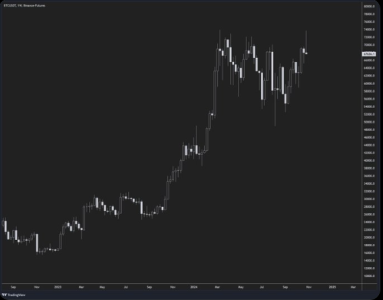Bitcoin’s Chart Patterns Suggest Potential End to Bullish Trend
In a critical turn for Bitcoin (BTC) enthusiasts and investors, recent chart patterns indicate a possible conclusion to the prevailing bullish trend. According to U.Today, which referenced an X post by the pseudonymous crypto trader Byzantine General, Bitcoin has formed a “gravestone Doji” candlestick on its weekly BTC/USDT chart—a bearish signal often interpreted as a harbinger of trend reversal. This development comes after Bitcoin surged past $73,000, approaching a new all-time high, only to retract to $67,000.

Understanding the Gravestone Doji
What is a Gravestone Doji?
A gravestone Doji is a specific candlestick pattern characterized by a long upper shadow and little to no lower shadow, with the open, low, and close prices being nearly identical at the bottom of the trading range. This formation typically occurs after a significant uptrend and is considered a strong bearish indicator, suggesting that buyers were unable to maintain the upward momentum, potentially signaling a reversal to a downtrend.
Significance in Technical Analysis
In the context of Bitcoin, the appearance of a gravestone Doji on the weekly chart implies that the bullish sentiment may be waning. Traders and analysts often view this pattern as a cautionary signal to prepare for possible price declines or a consolidation phase following the bullish surge.
Recent Price Movements and Indicators
Bitcoin’s Surge and Retraction
Bitcoin recently experienced a substantial price increase, breaching the $73,000 mark and nearing a new all-time high. However, this upward momentum was short-lived, as BTC retracted to $67,000. This significant dip highlights the volatility inherent in cryptocurrency markets and raises questions about the sustainability of the recent bullish trend.
Bollinger Bands Analysis
On the four-hour chart, Bitcoin dipped below the lower Bollinger Band. Bollinger Bands are a technical analysis tool that measures the volatility of an asset and identifies overbought or oversold conditions. When the price falls below the lower band, it often indicates that the asset is oversold and may be due for a price correction or bounce back. In Bitcoin’s case, this dip suggests increasing bearish sentiment and potential downward pressure.
Bullish Divergence on One-Hour Timeframe
Despite the bearish signals, a bullish divergence was observed on the one-hour timeframe. Bullish divergence occurs when the price makes a new low, but the corresponding technical indicator (such as the Relative Strength Index or RSI) forms a higher low. This pattern can signal a potential weakening of bearish momentum and the possibility of a price rebound.
Implications for Bitcoin Investors
Potential End to the Bullish Trend
The convergence of the gravestone Doji formation and Bitcoin’s dip below the lower Bollinger Band presents a compelling case for the potential end of the current bullish trend. Investors may need to reassess their positions, consider taking profits, or implement risk management strategies to mitigate potential losses in the face of rising bearish indicators.
Short-Term vs. Long-Term Outlook
While the bearish signals are concerning, the bullish divergence on the one-hour timeframe introduces an element of uncertainty. This suggests that while short-term bearish momentum may be emerging, there remains the potential for a price stabilization or even a short-term recovery. Long-term investors should weigh these signals against fundamental factors such as Bitcoin’s adoption, regulatory developments, and macroeconomic trends.
Strategic Considerations
Investors might consider the following strategies in light of the current technical indicators:
- Risk Management: Implement stop-loss orders to protect against significant downturns.
- Diversification: Spread investments across different assets to mitigate risks associated with Bitcoin’s volatility.
- Technical Analysis: Continue monitoring key support and resistance levels, along with other technical indicators, to inform trading decisions.
Expert Opinions
Dr. Emily Carter, Blockchain Analyst
“The formation of a gravestone Doji on Bitcoin’s weekly chart is a noteworthy bearish signal. Coupled with the dip below the lower Bollinger Band, it suggests that the market sentiment is shifting. However, the bullish divergence on the one-hour chart indicates that we should remain cautious and not interpret these signals in isolation.”
Mark Thompson, Financial Strategist
“Bitcoin’s recent volatility underscores the importance of technical indicators in guiding investment strategies. The gravestone Doji and Bollinger Bands dip are red flags for potential trend reversal, but the bullish divergence provides a counterbalance. Investors should stay informed and agile in their approach.”
Sarah Lee, Cryptocurrency Researcher
“While bearish patterns like the gravestone Doji can signal a potential end to a bullish trend, it’s essential to consider the broader market context. Factors such as institutional investment, regulatory changes, and global economic conditions will play significant roles in determining Bitcoin’s future trajectory.”
Future Outlook
Monitoring Key Support Levels
Investors should closely monitor Bitcoin’s performance around key support levels, particularly the $68,000 mark identified by analysts. Holding above this level could provide a foundation for a price rebound, while a break below may trigger further declines.
Impact of Federal Reserve Decisions
As the U.S. Federal Reserve approaches its decision on interest rates, scheduled for November 7, monetary policy will play a crucial role in shaping the cryptocurrency market. An easing of monetary policy could inject liquidity into the markets, potentially supporting Bitcoin’s price. Conversely, tightening measures may exacerbate bearish trends.
Technological and Adoption Factors
Beyond technical indicators, Bitcoin’s long-term outlook is influenced by its technological advancements, adoption rates, and competitive positioning within the broader cryptocurrency ecosystem. Continued improvements in scalability, security, and usability will bolster Bitcoin’s appeal and resilience against market fluctuations.
Conclusion
The recent formation of a gravestone Doji on Bitcoin’s weekly chart, combined with a dip below the lower Bollinger Band on the four-hour chart, suggests a potential end to the current bullish trend. While these technical indicators point towards increasing bearish sentiment, the presence of a bullish divergence on the one-hour timeframe introduces a degree of uncertainty. Investors must navigate these signals with a balanced approach, incorporating risk management strategies and staying attuned to broader market and regulatory developments.
As Bitcoin approaches critical support levels and with significant monetary policy decisions imminent, the cryptocurrency’s price dynamics remain highly sensitive. Maintaining a comprehensive understanding of both technical and fundamental factors will be essential for making informed investment decisions in the evolving digital asset landscape.
To stay updated on the latest developments in cryptocurrency market trends and technical analyses, explore our article on latest news, where we cover significant events and their impact on the digital asset ecosystem.
Disclaimer: The information provided is not trading advice, Bitcoinworld.co.in holds no liability for any investments made based on the information provided on this page. We strongly recommend independent research and/or consultation with a qualified professional before making any investment decisions.

